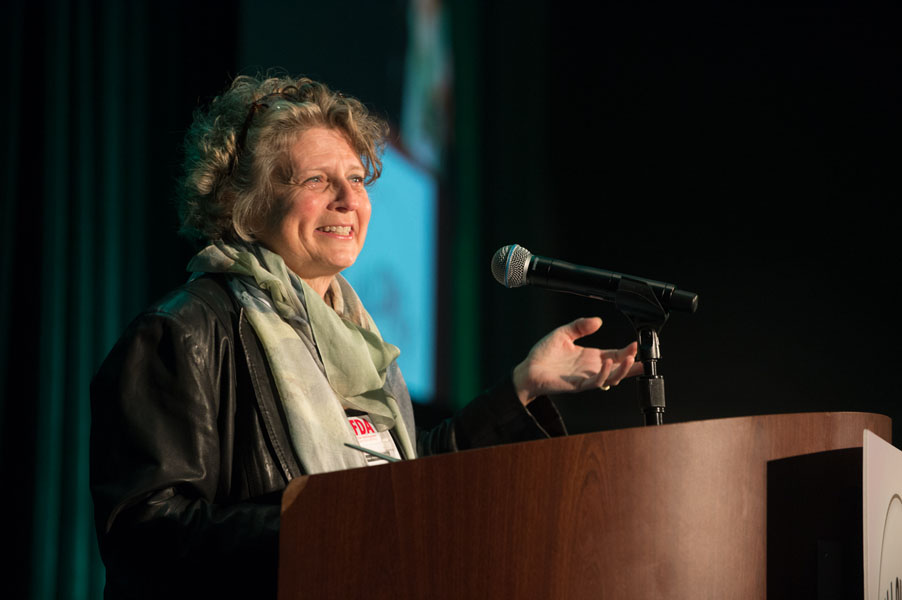PORTLAND, ORE.: Caffeine and other morning stimulants weren’t the only things waking up attendees on Friday morning, day two of Theatre Communications Group’s annual conference, “Full Circle.” The second plenary was all substance, some of it thorny, all of it essential hearing for the U.S. nonprofit theatre field. If there was one overarching message, it was: Let’s get out of our silos and work together for change.
Oregon Congressmember Suzanne Bonamici kicked off the morning with a taped message about the value of support for the arts. “Arts are essential to our humanity and our democracy,” said the woman who helped put the “A” in STEAM as founder and co-chair of the Congressional STEAM Caucus (the educational acronym, minus the “A” for “arts,” was STEM—science, technology, engineering, and mathematics).
Next, in accepting an award for Visionary Leadership, Berkeley Repertory Theatre managing director Susan Medak exposed one the field’s seldom publicly aired fault lines: between artists and management. She started with gratitude for the “extraordinary generosity of the field,” then challenged her colleagues to consider the future of arts managers in it. When young people she’s mentoring ask her, “Will there be a job that I still want when I’m ready to lead a company?”, she admitted she sometimes feels like she’s lying when she tells them, “Oh, yes, there will be.” Characterizing arts managers like herself as not motivated by “crunching numbers, but making theatre,” she called out artistic staffs for “becoming siloed over the years, as if they are the only keepers of the artistic flame,” in the process devaluing “the skills and expertise of administrators and skilled managers. We assumed that because someone was a good director, they must be good at marketing and long-range planning.”

The result, she said, is a field threatened by decline and beset by systemic challenges unprecedented since its beginning some 50-plus years ago. “I argue that great art alone is not going to save the theatre,” Medak said to a room full of both artists and administrators, and urged “artistic collaborators to form partnerships with managers—we may not be your collaborative partners in making plays, but we are definitely your partners in making your theatre…If we don’t start making these jobs attractive to talented young managers, I fear we’ll be making stunning theatre with no money and no audiences…I ask you not have you hugged your partner today—because of course you have—but have you had a really good, heady disagreement with your partner today? Have you covered each others’ asses today? If not, isn’t it about time?”
Her fiery speech helped explain what Berkeley Rep artistic director Tony Taccone, in remarks read by former “Berkeley Reptile” (now Woolly Mammoth managing director) Meghan Pressman, meant when he called Medak “a mixture of the Barefoot Contessa and Tony Soprano,” a “loving and tough” manager who “makes a mean brisket and knows how to use a gun.”
Another Berkeley-based leader, author and speaker Jeff Chang, next gave a bracing keynote about the precarious moment our nation faces, both placing it in a long-established cycle of racial retrenchment and division, and suggesting ways we might break out of that cycle. He began with some blunt theatre criticism of the current presidential administration and its high-stakes foibles: “We’re waking up every day to the worst kind of theatre. The performances are predictable. The writing is terrible. The words don’t even make sense—‘covfefe’?” More seriously, Chang said it typifies a vision of the world as a zero-sum game and perpetuates “systems that produce inequality, that do the greatest harm to those who can do the least to protect themselves.” This puts us at “a turning point” where “we can’t remain on the fence…In this moment, privilege shows up as disengagement, in the refusal to take a stand, the refusal to show up.”
What do art and theatre have to do with this? Said Chang, “Art reflects the ways we experience life…We believe in art, and we believe that violence and inhumanity must be transformed—that cultural change might even bring about political change.” Citing the words of Ralph Ellison and the model of the Black Arts Movement, Chang moved through a soberingly familiar history of segregation, not only in housing, educational, and income disparities but in our cultural sphere, where our major institutions and their boards remain stubbornly homogeneous and serve disproportionately white artists and audiences. What might dismantle this status quo? Chang held up the example of the hip-hop generation (a specialty of his), a movement “built from the ruins of civil society” by abandoned black and brown kids in the Bronx and then the whole nation. And in a quote that tied it all together, he cited author/activist Toni Cade Bambara: “The work of an artist is to make revolution irresistible.”
Chang didn’t flinch from bringing the message home to Portland, “the whitest big city in the U.S.,” and the state of Oregon, which was founded on explicit racial exclusion. “I don’t show these maps to denigrate Portland—I love Portland,” said Chang as slides illustrating the city’s siloed demographics screened. “In this it’s no different than any city.” The point, Chang said, is that while “we fight every day against the weight of history…history doesn’t need to be destiny. But it surely won’t change until we face up to it and choose to act.”
Chang wrapped up with a seemingly whimsical digression about “luxury doomsday bunkers,” which some obscenely rich people are constructing in abandoned missile silos to weather any impending apocalypse. The mini-trend epitomizes a larger movement of “complete and total withdrawal from the social—the imagination of the death spiral.” Beside an image from the film Moonlight, Chang concluded, “Here’s the strange truth: The best remedy may be more art. Art can be the remedy for the orientation toward death. When it seems we can’t see each other, that we’re distracted by spectacle, art may allow us to see again, to close the gaps again. Art helps to close the difference of self and other.”


